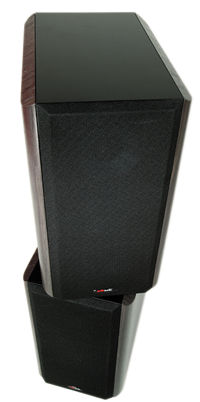Polk LSi9 surround speaker system
 I first heard the LSi9 in New York at Home Entertainment 2002, where Polk used them for their 2-channel demonstration. A mélange of other LSi-series speakers—floorstanders, wall-mounts, and a dedicated center-channel—was belting out home-theater and multichannel music demos. However, I was in quest of a pearl among marbles, and the smooth but deep LSi9 drew me out of my shell. I immediately began to imagine how a set of five affordable, identical LSi9s might expand the delectable 2-channel performance I'd just heard into a surround-sound extravaganza at home. The Polks were destined for a review.
I first heard the LSi9 in New York at Home Entertainment 2002, where Polk used them for their 2-channel demonstration. A mélange of other LSi-series speakers—floorstanders, wall-mounts, and a dedicated center-channel—was belting out home-theater and multichannel music demos. However, I was in quest of a pearl among marbles, and the smooth but deep LSi9 drew me out of my shell. I immediately began to imagine how a set of five affordable, identical LSi9s might expand the delectable 2-channel performance I'd just heard into a surround-sound extravaganza at home. The Polks were destined for a review.
Polk Salad
Viewed from the front, the Polk LSi9's tweeter lies between the two mid-woofer drivers, though not vertically in line with their axes. As such, these mirror-imaged pairs demand that you decide whether the tweeters should be closer or farther away from each other. Polk clearly recommends, in their manual and on the LSi9's rear panel, that the tweeters be toward the speakers' "inner" edges—but feel free to experiment. Sometimes, outside tweeter placement might enhance soundstage width, though not without risking image specificity.
Polk uses an asymmetrical crossover, highpassing at a steeper, driver-safe, third-order slope to the tweeter, while lowpassing to the two mid-woofers at two different frequencies, with a less phase-anomalous second-order slope. The two identical mid-woofer drivers operate together below 200Hz, but one rolls off above that point. The second stays active to cover the rest of the frequency range up to 2.4kHz, where it hands off to the tweeter.
The speaker grille can be omitted easily enough, and though its slight frame never seemed to cause a problem, my kids are all past the finger-polking—er, finger-poking phase, so I left the front trio nude. Around back, the LSi9's single port fires into a rear-mounted turbulence muffler that sits a few inches off the rear baffle.
Two pairs of speaker posts allow for biwiring or biamping when the short metal jumpers between the pairs are removed. I initially biwired the Polks, but switched to single wiring while troubleshooting a busted speaker. The top pair of posts offered poor access for my AudioQuest post-tightener, and the lower two speaker posts were a bit difficult to use as well. Give me large, cheap, perpendicular plastic nuts over fancy gold posts any day of the week. Better yet, give me something I can whale down on with a quarter.
 The LSi9 is available with natural cherry or black wood veneered side panels. The cherry style is finished nicely, considering the price, and the high-gloss top, bottom, and baffle are attractive as well. Depending on the viewing angle, those reflective black surfaces might prove a distraction in a darkened front-projector setup, though they were fine in my case. I wish I could say I warmed up as easily to the black models as I did to the cherry, but they paled in comparison. For one thing, their "wood" is more dark gray than black, and doesn't go well with the deep, polished black of the rest of the speaker.
The LSi9 is available with natural cherry or black wood veneered side panels. The cherry style is finished nicely, considering the price, and the high-gloss top, bottom, and baffle are attractive as well. Depending on the viewing angle, those reflective black surfaces might prove a distraction in a darkened front-projector setup, though they were fine in my case. I wish I could say I warmed up as easily to the black models as I did to the cherry, but they paled in comparison. For one thing, their "wood" is more dark gray than black, and doesn't go well with the deep, polished black of the rest of the speaker.
Polk Tale
Polk sent me three boxed pairs of LSi9s, including one pair that they claimed had been "substantially broken in." Two months into the review, I took the break-in process of the front right speaker to its ultimate extreme. That's when I discovered that the spare in the original sextet was inoperative—apparently a victim of shipping damage. Fortunately, Polk was able to send out a fourth pair immediately.
The LSi9 is not a large speaker, and so is intended for stand-mounting. My usual choice in stands, the 24-inch Standdesigns, were too low for all but the center-channel, but a pair of 30-inch-high Sanus stands in the front put the speakers' tweeters almost exactly at ear level. The LSi9s' front baffles extended out about 36 inches from my room's front wall; behind me, the breathing space was twice as generous.
I experimented with the Polks' lateral placement. I found that about 8 feet of separation between the left and right speakers worked best, with sufficient toe-in that the tweeter axes intersected at my head. The rear channels were angled in as well, though to a lesser degree, intentionally minimizing pinpoint imaging from the rear. With few exceptions, I always ran the system with a subwoofer handling material below 80Hz.






























































